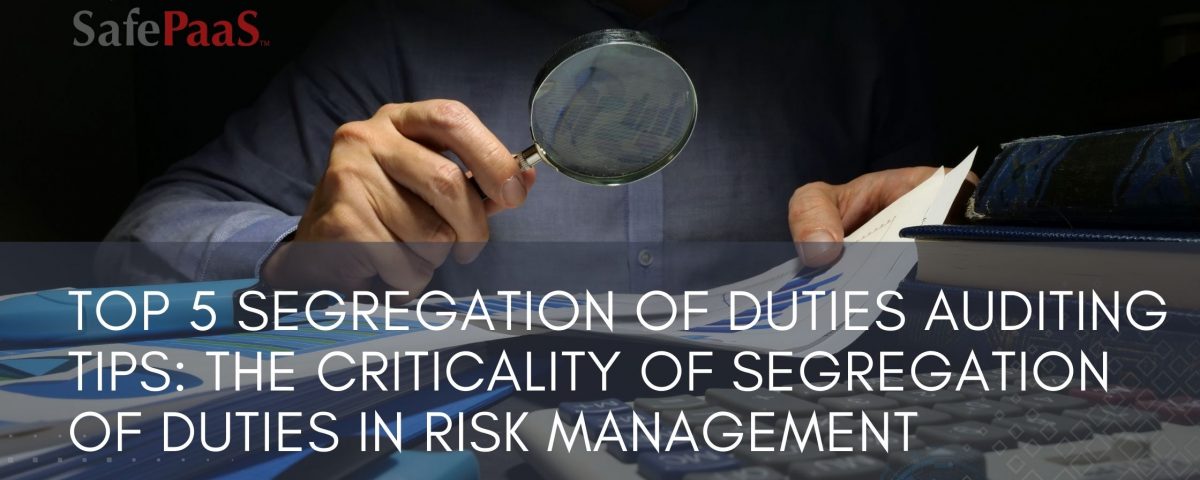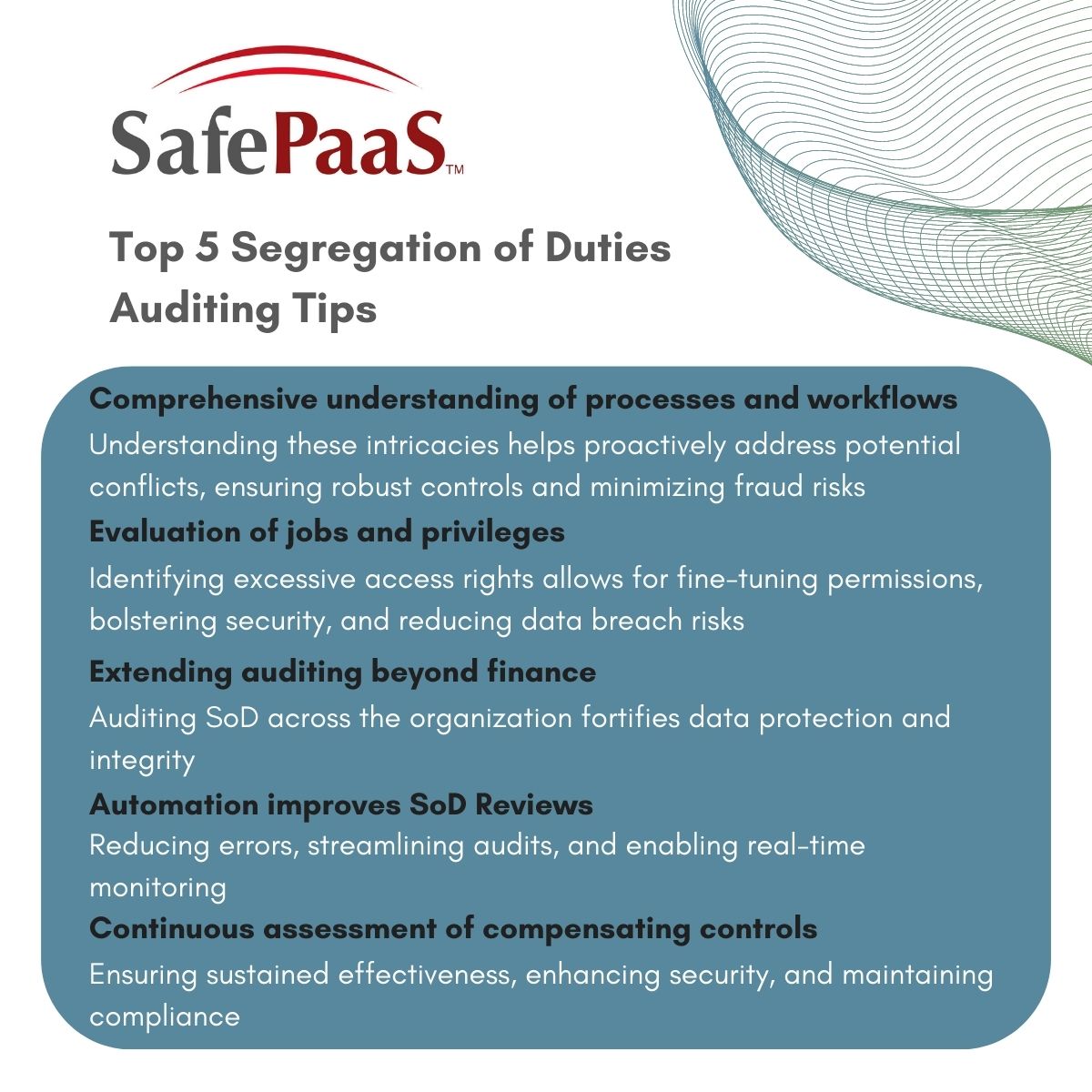Top 5 Segregation of Duties auditing tips


Top 5 Segregation of Duties Auditing Tips:
Understanding the Criticality of Segregation
of Duties in Risk Management
Segregation of duties (SoD) is one of the most impactful internal controls your organization can use to minimize risks and maintain the integrity of your operations and financial systems. SoD also protects against intentional wrongdoing and inadvertent errors and provides your stakeholders with greater confidence in the reliability of your business processes and financial data.
Traditionally, Segregation of Duties is siloed and monitors a single application or process. But business has transformed. Applications and cloud technology have proliferated, creating more workflows, integration points, and mitigating controls that must work harmoniously across many applications. Here are five tips to help you elevate your SoD auditing into the next generation.
Top 5 tips for next-generation Segregation of Duties auditing
1. Have a strong understanding of your organization's processes and workflows
Having a comprehensive understanding of your organization's processes and workflows is crucial in effectively managing and auditing SoD. By understanding the intricacies of your processes, you can identify critical control points, and address potential SoD conflicts, to ensure a strong internal control system that minimizes your risk of fraud, data breaches, or compliance violations.
A thorough understanding of your processes also helps you to:
- Identify key segregation points
- Assess risks
- Customize evaluations
- Assess effectiveness
- Identify weaknesses
- Ensure compliance
- Recommend improvements, and
- Adopt a risk-based approach
These critical factors form the foundation for a comprehensive and effective SoD audit, strengthening your internal control environment.
2. Evaluate job requirements and privileges
Thoroughly assessing your job requirements and associated privileges is key to achieving SoD compliance. Evaluating job and privilege requirements helps identify accounts with excessive access rights, allowing you to fine-tune permissions and bolster security measures like the principle of least privilege, reducing your likelihood of unauthorized actions or data breaches.
Additionally, reviewing job requirements and privileges enhances SoD audits by:
- Defining clear roles
- Mapping access rights
- Identifying risks
- Ensuring policy compliance
- Assess authorization controls
- Detect unauthorized access, and
- Enable continuous improvement
Assessing job roles and privileges ensures effective SoD auditing aligned with your business objectives and security policies.
3. Extend Segregation of Duties auditing beyond finance
Broadening the scope of your SoD auditing beyond finance, particularly in IT, is essential for your organization's comprehensive risk management. Your digital enterprise's control framework includes your business processes and the corresponding IT systems that execute them. Therefore, segregation of duties must also extend to the associated IT systems, especially when they span multiple applications.
To ensure the secure execution of your organization's business processes, it is essential to establish a division of responsibilities and reflect it in the access privileges granted to users. Extending the segregation of duties beyond finance is necessary for a well-rounded risk management strategy that safeguards your entire organization from potential threats, fraud, and compliance issues.
By emphasizing SoD reviews in IT and other critical areas, you will fortify your data protection, prevent security breaches, and maintain data integrity.
4. Adopt automation in Segregation of Duties reviews to improve accuracy and efficiency
Embracing automation in your organization's SoD reviews can significantly enhance the accuracy and efficiency of the auditing process. By reducing manual intervention, you can minimize the chances of errors and streamline the review process, allowing for real-time monitoring and quick identification of potential conflicts.
Automation also enhances SoD reviews by enabling you to:
- Gather and analyze large volumes of data from various sources, reducing manual efforts and errors
- Enable real-time monitoring for rapid identification of violations and suspicious activities
- Apply predefined rules for consistent and standardized evaluations, reducing subjectivity
- Handle increased data complexity, ensuring scalability as your organization grows
- Rapidly flag potential violations and expedite identification
- Generate comprehensive reports for effective communication with stakeholders and auditors
- Minimize manual work, allowing you to focus on higher-value tasks
- Integrate with IAM systems for streamlined access management
- Create audit trails for enhanced accountability and transparency
- Adapt to changes in processes or systems, ensuring up-to-date reviews
Automation streamlines your organization's SoD audits and enables proactive compliance, reducing fraud and unauthorized access risks.
5. Continuously assess Segregation of Duties compensating controls for sustained effectiveness
Regularly evaluate your organization's SoD compensating controls to ensure their ongoing effectiveness. Proactively review and update these controls to strengthen your organization's security posture and mitigate the threat of emerging risks while maintaining compliance.
Continuous assessment of your SoD compensating controls also ensures prompt identification and resolution of deviations, leading to sustained effectiveness, proactive risk mitigation, compliance with laws and regulations, adaptability to changes, and improved business performance. It also fosters a control-conscious culture, streamlines audits, and strengthens stakeholder confidence, contributing to your organization's long-term resilience.

How can access governance platforms increase the effectiveness of your SoD audits?
Access governance platforms can significantly increase the effectiveness of your SoD audits by providing a comprehensive set of tools and functionalities that streamline the entire process. Here are several ways an access governance platform can enhance the effectiveness of your SoD audits:
- Comprehensive visibility and analysis: An access governance platform offers fine-grained visibility into user access rights, roles, and permissions across your organization's various systems and applications. This lets you easily analyze and map out the access landscape, identifying potential SoD conflicts.
- Automated access reviews: The access governance platform automates the access review process, allowing you to schedule regular reviews of user access rights based on predefined rules and policies. Automated reviews ensure up-to-date access privileges, reducing the risk of unauthorized access and potential conflicts.
- Real-time monitoring and alerts: An access governance platform provides real-time monitoring capabilities, flagging any potential SoD violations or suspicious activities as they occur. This enables prompt identification and resolution of conflicts, minimizing the risk of fraud and security breaches.
- Identification of compensating controls: The platform helps identify and assess your compensating controls that mitigate the risks associated with specific SoD conflicts. It ensures that these controls are effective and continuously monitored for sustained compliance.
- Policy-based access control: Best-of-breed access governance platforms enable you to implement policy-based access controls, ensuring that users are assigned only the necessary access rights for their job responsibilities. Applying the principle of least privilege reduces the likelihood of potential SoD conflicts.
- Detailed reporting and auditing: A platform can generate comprehensive reports and audit trails, providing detailed insights into your SoD audit results. These reports facilitate clear communication with stakeholders and auditors, demonstrating your compliance and control measures.
- Integration with identity and access management systems: An access governance platform can seamlessly integrate with your IAM systems, ensuring smooth access management and synchronization of user access rights across your organization.
- Continuous monitoring and improvement: A platform enables your organization to proactively address any emerging SoD issues by continuously monitoring access rights and conducting regular reviews. It allows you to refine your access control policies over time, improving the effectiveness of your SoD audits.
An access governance platform equips your organization with advanced features and capabilities that enhance the effectiveness of segregation of duties audits. By leveraging the platform's functionalities, your organization can strengthen its internal controls, minimize the risks of fraud and compliance violations, and maintain a robust SoD framework.
In the dynamic and ever-evolving landscape of risk management, achieving a strong SoD framework has become paramount for safeguarding your organization against fraud, data breaches, and compliance violations.
The power of access governance in SoD excellence cannot be understated. Embracing the capabilities of an access governance platform allows organizations to optimize SoD management, streamline access reviews, and tackle modern-day challenges head-on. As businesses venture into the future, leveraging the synergistic potential of understanding, evaluation, and automation will be the key to maintaining a powerful defense against ever-evolving risks.
* This blog was inspired by a LinkedIn post by Salih Ahmed Islam, “5 Mistakes to Avoid when Auditing SoD.”

